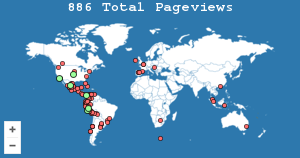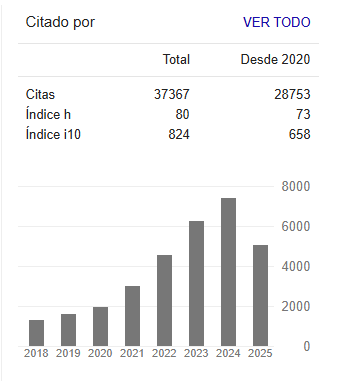Analysis of political discourse from neurocommunication: a practical case
Abstract
The objective of the work consisted of analyzing the political discourse from the approach of neurocommunication applied in the speech made by the former president of Venezuela, Hugo Chávez, on September 20, 2006, at the UN towards the achievement of political objectives in order to to identify findings. The material, arranged on video, was analyzed in several ways: the visual and auditory material and the transcription of said material following the construct analysis methodology (McDaniel & Gates; 2016) and the analysis of elements found in the bibliographic review that include : use of Goebbels - Domenach principles, use of neuromarketing effects, voice management and gesture management. The results showed that storytelling and metaphors were used, which used historical, social, emotional and future elements, in relation to the filters that are activated in the brain according to the theory of neurocommunication and a successful management of kinesia. of voice and gestures. It can be concluded that these techniques will allow making powerful political speeches that generate remembrance and meet the objective of convincing, persuasion and mobilization of the masses.
References
Albelo, E (2013). Definición de Yanqui, historia y verdadera definición. «Albelo59. https://ealbelo59.wordpress.com/2013/09/09/definicion-de-yanquihistoria-y-verdadera-definicion/
Álvarez del Blanco, R (2011). Neuromarketing Fusión Perfecta. Pearson Educación S.A.
Braidot, N (2017). ¿En qué consiste la neurocomunicación? – Palermonline. http://palermonline.com.ar/wordpress/?p=66597
Cáceres, F (2007). Neurocomunicación, la nueva ciencia de la comunicación con poder. bubok.es.
Cossio, H (2014). Neurociencia: la disciplina que propone identificar qué hay en el cerebro de los políticos. El Mostrador. https://bit.ly/3bJ9Hzl
Cuesta-Cambra, U., & Rodríguez-Terceño, J. (2017). El procesamiento cognitivo en una app educativa con electroencefalograma y « Eye Tracking ». Comunicar, XXV(52), 41-50.
Damasio. H., y Damasio, A.R. (1980). The anatomical basis of conduction aphasia. Brain, 103(2), 337–50. doi: https://doi.org/10.1093/brain/103.2.337
De Biase, M (2011). libreta chatarra: frases de «Los agentes del destino». http://libretachatarra.blogspot.com.co/2011/06/frases-de-los-agentes-del-destino.html
Ekman, P. (2002). Facial Action Coding System (FACS). A Human Face. http://ci.nii.ac.jp/naid/10025007347/en/
Ekman, P. (2017). Micro Expressions. https://www.paulekman.com/micro-expressions/
Ekman, P., & Friesen. (1978). FACS (Facial Action Coding System). https://www.cs.cmu.edu/~face/facs.htm
ESCO UNIVERSITAS (s. f.). NeuroComunicación: los 4 filtros - Esco E-Universitas. https://www.escoeuniversitas.com/neurocomunicacion-los-4-filtros/
Gamero, A (2015). El verdadero significado de la palabra «orwelliano» | Culturamas, la revista de información cultural. http://www.culturamas.es/blog/2015/11/15/el-verdadero-significado-de-la-palabra-orwelliano/
García, E. G., Marqués, J. G., & Unturbe, F. M (2011). Neuronas Espejo y Teoría de la Mente en la Explicación de la Empatía. Ansiedad y Estrés, 17(2-3), 265-279.
Hernández, M. G., & Avendaño, R. R (2008). Análisis de la Política Económica en Venezuela. 1998-2006 Analysis of the Economic Policy in Venezuela. 1998 - 2006, 25-47.
Instituto Cervantes (s. f.). CVC. Diccionario de términos clave de ELE. Variedad lingüística. https://bit.ly/39KKzaB
Kuhl, P. K. (2004). Early language acquisition: cracking the speech code. Nature Reviews Neuroscience. https://doi.org/10.1038/nrn1533
Lakoff, G., & Mora, M (2007). No pienses en un elefante: lenguaje y debate político. Editorial Complutense S.A., Ed. https://doi.org/10.1075/ni.16.1.26ram
Ledesma, M., & Fenger, N (2015). NeuroComunicación Avanzada. (1.a ed.). Editorial Jurídica del Ecuador.
Manes, F (2015). ¿Qué pueden aportar las neurociencias a la política?. Facundo Manes. https://facundomanes.com/2015/06/02/que-pueden-aportar-las-neurociencias-a-la-politica/
Masters, R., & Ferguson, M (1996). La Neurocomunicación: Transforma Su Cuerpo Mientras Usted Lee. 142. https://bit.ly/3oyR7gn
McDaniel, C. J., & Gates, R (2016). Investigación de Mercados. Learning, Ed. (10.a ed.).
Misiego, F. (2011). Neuromarketing Político (2da ed.). Madrid: Editorial Rasche.
Morgado, I. (2005). Psicobiología del aprendizaje y la memoria. CIC: cuadernos de información y comunicación, (10), 221-233.
Moya-Albiol, L., Herrero, N., & Bernal, M. C (2010). Bases neuronales de la empatía. Revista de Neurología, 50(2)., 89-100.
Natal, D., & Carruesco, F (2015). Si hablamos de neuromarketing, ¿podemos hablar de neurocomunicación?. Desarrollando Ideas, Llorente & Cuenca, 8-10. https://bit.ly/39SoXsL
Nolfi, G. (2011). Adjustment Bureau. USA.
Olson, G (2008). De las neuronas espejo a la neuropolítica moral. Polis, 7(20), 313-334. https://doi.org/10.4067/S0718-65682008000100017
ONU. (s. f.). Reglamento de la Asamblea General. http://www.un.org/es/ga/about/ropga/ropga_anx4.shtml
Pinker, S. (1994). The language instinct: how the mind creates language. New York: W. Morrow and Co.
Rosen, D. (2014). The candidate´s new clothes. Campaigns and Elections, (May/June)., 34-35.
Sánchez, D. (2016). Neurociencia y marketing político: Las emociones hacen la diferencia en una campaña | Cerebro en práctica. https://bit.ly/33SjONz
Sota, I. (2015). El análisis de las emociones de los políticos en el debate que revela quién sintió miedo, sorpresa o tristeza. https://bit.ly/3qHIfqK
Sota, I. (2017). Donald Trump, analizado por la neurociencia. https://bit.ly/3gPZMJ3
Suárez, A (2009). NeuroComunicación. http://definiciondepnl.blogspot.com.co/
Timoteo, J (2007). Neurocomunicación. Propuesta para una revisión de los fundamentos teóricos de la comunicación y sus aplicaciones industriales y sociales. Mediaciones Sociales. Revista de Ciencias Sociales y de la Comunicación, 1(junio-diciembre), 355-386. https://bit.ly/3glp5C9
Toledo, C (2016). 5 tipos de gestos y su influencia en la comunicación no verbal. http://www.analisisnoverbal.com/tipos-de-gestos-en-comunicacion-no-verbal/
Traver, F (2007). ¿Qué es un discurso?: El poder de la palabra. Neurociencia neurocultura. https://bit.ly/33Pltna
Valls, X (2013). Neurociencia aplicada al Marketing Político. MPR Group. http://mpolitico.com/2013/03/19/neurociencia-aplicada-al-marketing-politico/
Vera, L. (2008). Nueva sociedad. Revista Política y Cultural Nueva Sociedad Limitada. http://nuso.org/articulo/venezuela-1999-2007/
Weinstein, S., Weinstein, C., & Drozdenko, R (1984). Brain Wave Analysis. Psychology and Marketing, 1(1), 17-42.








.png)






























